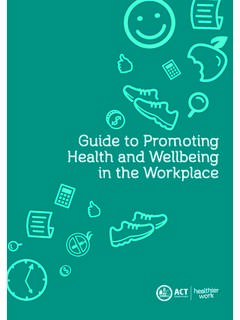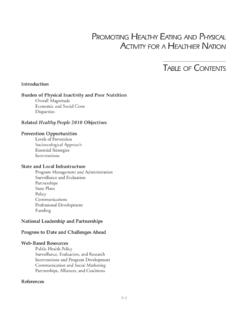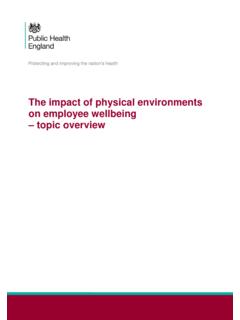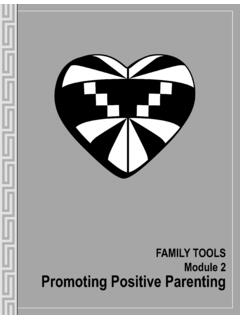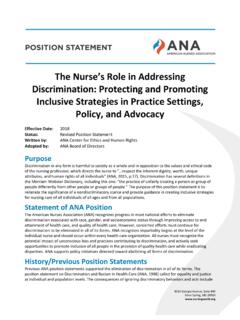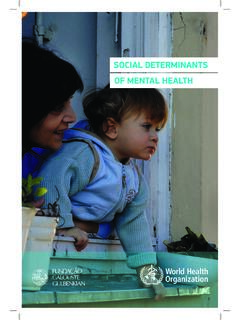Transcription of Promoting Positive Community Norms
1 Promoting Positive Community NormsA Supplement to CDC s Essentials for Childhood: Steps to Create Safe, Stable, Nurturing Relationships and EnvironmentsNational Center for Injury Prevention and Control Division of Violence Prevention23 This guide provides information about creating a context for increasing safe, stable, nurturing relationships and environments for children and families by Promoting Positive Community Norms . The key aim is to provide prevention leaders one way of learning about the power of Positive Community Norms , the importance of understanding the difference between actual and perceived Norms , and the ways they can grow Positive Norms in their Power of Promoting Positive Community NormsRecognizing safe, stable, nurturing relationships (SSNRs) and environments as essentials for childhood provides a new and exciting shift in the prevention of child maltreatment. This focus on healthy relationships moves beyond focusing on reducing risk. To be successful in increasing safe, stable, nurturing relationships and environments in our communities, we will need broad engagement with not just parents and primary caregivers, but with all those who provide such relationships with children (teachers, day care providers, and coaches), as well as those in decision-making positions (healthcare providers, school principals, and elected officials).
2 To foster broad engagement and adoption, it is critical to establish a context in our communities that supports safe, stable, nurturing relationships and way to think about Community context is by examining Norms . Norms are defined as those values, beliefs, attitudes, and behaviors shared by most people in a group. 1 In other words, Norms are what most people value, believe, and do. The group could be a physical Community (like a town or county), students within a school, employees of an organization or workplace, people linked by a common experience (such as first-time parents), or any other affiliation that allows individuals to establish a group , a group s Norms align with child well-being. For example, if survey data show that most people in the Community recognize the importance of early childhood education and believe it should be readily available in their Community , then such support is the normative attitude or the Community norm . Early childhood education is expected in the Community and this support might also be expressed in perceptions, language, voting behavior, and public conversations.
3 This Community norm about early education is an example of a Positive norm because it is associated with improved health and safety. For example, in preventing child maltreatment, Positive Norms may include valuing children as special members of our Community , using age-appropriate discipline, providing engaging activities and interaction, supporting public investment in quality day care services, and the like. There are many Positive Norms that are associated with improving child foster a broad context in support of safe, stable, nurturing relationships and environments, it is helpful to increase Positive Norms within our communities: among individuals, families and peers; workplaces, schools, and Community organizations; local governments and entities; and state organizations. While it may seem daunting, there is tremendous opportunity to embed support for safe, stable, nurturing relationships in a Community s culture by strengthening Positive Norms across these different levels of Community systems known as the social ecology.
4 (Figure 1) Prevention strategies should include a continuum of activities that address multiple levels of the social ecological model. These activities should be developmentally appropriate and conducted across the lifespan. This approach is more likely to sustain prevention efforts over time than any single intervention. Figure 1 The Social Ecological Model for Violence PreventionSocietalCommunityRelationshipI ndividual4 Through years of research and engagement in Community -based projects, prevention leaders have learned the importance of Promoting Positive Community Norms . This approach is founded on the principle that the solutions to issues such as preventing child maltreatment exist in our communities. Such a belief establishes hope for the future and thereby creates energy for engagement for local practitioners. Promoting Positive Community Norms does not deny or minimize the very serious and prevalent issues of child maltreatment, but instead promotes hope from a strength-based orientation.
5 It is through this combination of concern and hope that communities can do the work of growing safe, stable, nurturing relationships and environments. Creating a context of Positive Norms matters because it establishes an expectation and acceptance of healthy attitudes, behaviors, programs, and policies. Momentum for Positive change grows when more people in a Community recognize that the Norms of people around them support such MatterThus far, we have discussed actual Norms the actual values, beliefs, attitudes or behaviors shared by most members of a group. But it is essential to recognize that Positive Norms are often misperceived. Therefore, it is important to examine both actual Norms and the perception of Norms , or perceived Norms . Perceived Norms are what individuals think are the actual Norms of a group of people. For example, research involving parents and their protective behaviors with adolescent children found that most parents (86 percent) always knew when their teenage children did not come home on time.
6 Among these parents, there was a norm of parental monitoring. However, this norm was not accurately perceived. In fact, when asked their belief about this behavior for other parents, only 6 percent of these same parents thought this behavior was the Misperceptions of Norms occur not only for Norms about behaviors but also Norms about beliefs (see box on page 5 for more examples of actual and perceived Norms ). 5 Examples of Survey Results of Actual and Perceived NormsAmong parents in Montana, when asked about school truancy: 60% of parents surveyed said they would be extremely concerned if their teen skipped school one or two times during the semester (actual norm ); however, only 15% of these same respondents thought that typical Montana parents of teens would be extremely concerned (perceived norm ). (Source: Montana Parent Norms Survey, 2000, n = 787.)Among adults in Wyoming, 75% reported they strongly agreed that adults who supply alcohol to youth under age 21 in violation of Wyoming law should be prosecuted (actual norm ); however, only 22% perceived that MOST Wyoming adults would strongly agree (perceived norm ).
7 (Source: Wyoming PCN 2008 Community Survey Results, n=4659.)Among adults in Idaho, 82% reported they had NOT driven a motor vehicle within two hours after drinking alcohol in the past 60 days (actual norm ); however, 95%, perceived that MOST Idaho adults had driven after drinking (perceived norm ). (Source: Idaho 2011 PCN Community Survey, n=553.)Among parents of high school students in Minnesota, 92% of parents responded that they did not allow their child to drink alcohol (actual norm ); however, 84% of parents who responded perceived most parents of students in their child s school allowed their children to drink (perceived norm ). (Source: Minnesota PCN 2010 Parent Survey, n=274.)Research shows that perceptions of Norms can be strong predictors of behavior. Experiments have shown that perceived Norms influence a wide variety of behaviors including high risk drinking,3 tobacco usage,4 impaired driving,5 home electrical usage,6 bullying,7 and even the use of However, perceived Norms often remain hidden because we do not ask the right questions to measure them.
8 Both actual and perceived Norms are important. A number of psychosocial theories predicting individual behavior recognize that perceived Norms can influence the decisions of individuals within that group. We are social beings who look for cues in our environments about how to think, act, and belong. One way we search for these cues is by looking to the opinions and behaviors of others, as well as those expressed in the media. Therefore, even if the norm within a group aligns with improved health and safety (such as using age-appropriate discipline), if parents misperceive the norm and believe that most people do not use age-appropriate discipline, those parents may be more likely to engage in similar behavior. Normative misperceptions may not only create risk for engaging in unhealthy behaviors, but they can also inhibit protective practices across the social ecology. For example, if key leaders perceive that most of the members of their Community oppose implementation of a new program, the leaders may be less likely to support the program themselves, even if most people actually do support the program.
9 Correcting this misperception could be a critical step in fostering the adoption of the new , the work of Promoting Positive Community Norms to create a context supportive of safe, stable, nurturing relationships involves more than just focusing on actual Norms ; it must also include correcting misperceptions of Norms . These normative misperceptions are pervasive across the social ecology and influence a wide variety of behaviors, both risky and protective. For the Community leader seeking to promote Positive Community Norms to support safe, stable, nurturing relationships and environments, understanding the roles of accurate perceptions and misperceptions is critical. Strategies to grow Positive Community Norms are explored in the next Steps for Promoting Positive Community NormsThe work of Promoting Positive Community Norms can be daunting. While a high percentage of people in a Community may agree with supporting child well-being and reducing child maltreatment, their misperceptions about the Norms of their Community (and of specific groups within the Community ) can be very strongly held and can inhibit progress.
10 Challenging misperceptions of Norms is really about challenging people s core assumptions. And when we challenge people s core assumptions, they may become anxious and appear resistant. Research on Positive Community Norms informed the development of a seven-step process to grow Positive Community Norms at state and Community Clearly, each Community s journey is unique, and there is still much to learn through ongoing research. Development of these seven steps has continued to evolve with different projects and issues. While these steps are presented as if they are linear, many of them will overlap and, in fact, they will eventually loop back to the beginning in a cyclical process. 7 Step 1. Planning, Engaging, and EducatingAny comprehensive effort to grow Positive Community Norms should be well thought out, engage the necessary partners, and receive appropriate resources. While we all become excited to get into the work, conducting careful planning and engaging partners and stakeholders is part of the work.











